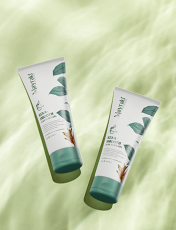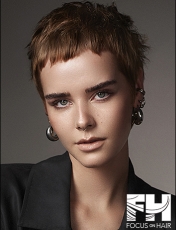
 David Stanko uniquely combines his skills as a corporate executive with his reputation as one of the most accomplished hair colorists in America. He has been involved in every facet of hair coloring for both startup companies and established industry leaders. His A-to-Z experience includes helping develop, test, and launch both professional and consumer hair color brands, creating formulation and technique guides, teaching around the world, and working in top NYC salons. He is the author of Formula Boss Volumes I, II and III, and Color Conversion Made Easy. Additionally, he conceptualized, directed, and starred in the Lifestyle Coloring DVD
David Stanko uniquely combines his skills as a corporate executive with his reputation as one of the most accomplished hair colorists in America. He has been involved in every facet of hair coloring for both startup companies and established industry leaders. His A-to-Z experience includes helping develop, test, and launch both professional and consumer hair color brands, creating formulation and technique guides, teaching around the world, and working in top NYC salons. He is the author of Formula Boss Volumes I, II and III, and Color Conversion Made Easy. Additionally, he conceptualized, directed, and starred in the Lifestyle Coloring DVD
In a recent interview with Focus on Hair, David gave us a glimpse into his world of color and all of the things that have aligned to make him the coveted Formula Boss.
FOH: How long have you been “playing” with hair?
DS: To be honest, I consider what I do with hair, in my case hair coloring, to be a practice. I don’t “do hair” or “play with hair.” Lately, I like a more serious approach and take inspiration from yoga: a group of physical, mental and spiritual practices or disciplines.
This is how I look at the practice of coloring, styling and cutting hair.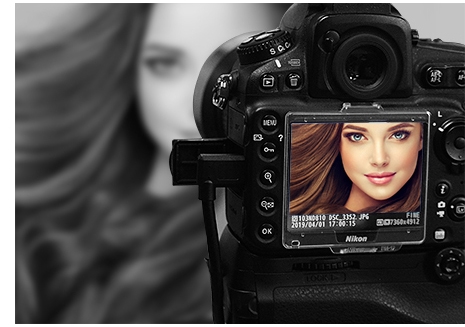
FOH: Was hair always your first love or was there another passion pre-David Stanko hair artist 1.0?
DS: As a child, I was always into creative expression and working with my hands. Everything from an erector set to leathercraft to calligraphy. Early on I took an interest in photography, which later led to working in a photo studio. My father was also very handy and creative. We owned a Junktique store. I hated it, but it was mandatory to help refinish antique furniture, go to auctions and help my dad merchandise the store. I learned a lot about furniture, gold coins, and fine jewelry. It helped me develop an eye for detail and a habit of making careful evaluations.
FOH: What was your “aha” moment when you realized that hair color was your “thing”?
DS: My intrigue with hair color started as a student at Pittsburgh Beauty Academy. One day in clinic, I applied a blonde hair color that turned a woman’s hair khaki green. Opps. To correct it, the instructor mixed Clairol 33R Flame with 10-volume developer and shampoo, and said, “Put this on her hair at the bowl; tell her it's a conditioning treatment and whatever you don’t let her look in the mirror!” I was hooked.
FOH: Did you have any mentors when you first started?
DS: Back in 1986, from a personal financial side, my accountant and friend Ken taught me the value of saving for a rainy day and how to maintain good bookkeeping records. On the salon side, Donna and Larry Blanchard, the salon owners I assisted six months out of school, were my first mentors. Donna was the queen of manipulating hair—and her clients. She was masterful at “repurposing” styling tools, like a Jilbere curling brush to tease and style hair, and she did it for all the society women of Pittsburgh. She was one of the first hairdressers I knew who really followed fashion. She dressed in Chanel and Comme des Garçons and actually bought the products that appeared in the pages of Vogue magazine. An additional shoutout goes to the folks at It&ly HairFashion. In the early 1990’s they were integral in my success as an educator. Founder Lucio Fusaroand U.S. President Jim Sangermano put me on the road and I never looked back.
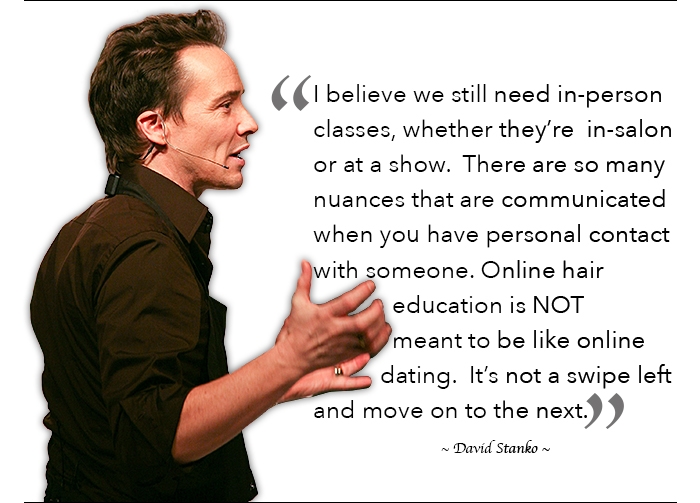 FOH: Who influences you the most with hair/hair color now?
FOH: Who influences you the most with hair/hair color now?
DS: So many people, brands, salon pros, celebs, actors that I don’t want to name names for fear of missing someone. I’m a big down-the-rabbit-hole Instagram and Google fan. Here’s what I do: Click on a pic and see who commented or follows that person. Next, I check out the hashtags they use, click on the hashtag and discover more creative looks. It's a part-time job to keep up. Pre-social media, we’d look to magazines, TV, award shows, singers or the club scene to spot a trend. Today, it's a free-for-all.
FOH: What is your favorite type of projects to work on?
DS: I have three favorites, in no particular order: Being on camera as a spokesperson or interviewer - just because I like the whole process of production. Hair color development. I’m in hair color heaven when I can apply, analyze and collab with cosmetic chemists. In the process, I learn as much as I share. Chemists and hairdressers speak very specific languages, and I’m the hair color whisper who translates these two dialects from one to the other. And I really like coloring models for ad campaigns and being on set for the shoot. It’s a whole behind-the-scenes vibe with a focus on the models and keeping them in good spirits to deliver the perfect shot.
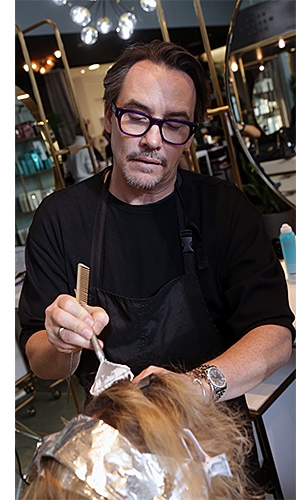 FOH: Where do you find your inspiration when creating new looks?
FOH: Where do you find your inspiration when creating new looks?
DS: I’m a voyeur and I travel a lot, so airports, museums, and cafes are the best places for trend spotting and people watching. I’m always doing hair in my head, performing a makeover or a makeunder on the person I’m looking at.
FOH: What industry icon (alive or not) do you wish you could have a conversation with? What would you ask them?
DS: I would like to have lunch with Eugène Schueller, the French pharmacist and entrepreneur who was the founder of L'Oréal, Professor Victor Auger, who employed Schuller as a lab assistant in 1909, and the infamous owner of a large barbershop who visited Auger seeking help in developing a synthetic hair dye. Isn’t it obvious what I’d ask? Whose idea was the hair dye? What happened?
FOH: What do you think of today’s mainly online education versus how it was “back in the day”?
DS: Well, times change and so must we. I think online education serves a purpose in that it trains your eye. In a fragmented and ever-changing industry, online education provides access to training in a quick, fun and sometimes over-stimulating way. It fills a void that can’t possibly be filled by manufacturers today. I used to go into salons on a Sunday or Monday and have nearly a full house. But with the existence of the salon suites, booth renters and salon fragmentation, it’s almost impossible to reach the same people in the same way.
Also, online education is fully mobile--there are dozens of nifty new apps that have tutorials.
That said, I believe we still need in-person classes, whether they’re in-salon or at a show. There are so many nuances that are communicated when you have personal contact with someone. Online hair education is NOT meant to be like online dating. It’s not a swipe left and move on to the next.
We need in-person education and hands-on education in particular. It should be masterfully delivered by a seasoned pro who is trained to hone in on your particular way of learning and who can customize the material, conversation, and coaching in a way that will resonate with you.
I’d like to see a collaborative hair show and hands-on workshop that alternates between online influencers and “back-in-the-day” educators. And then poll the attendees afterward for their opinion on showmanship, professionalism, retention of information, acceptability of techniques and product knowledge.
 FOH: Do you find that living in the age of digital photo shoots has made hair artists lazy (retouching, filters, etc.)?
FOH: Do you find that living in the age of digital photo shoots has made hair artists lazy (retouching, filters, etc.)?
DS: Not really. There were always post-production edits and tricks. Stylists who are truly competent want to nail the look without relying on filters. Plus, in today’s responsible retouching world, all eyes are watching for disingenuous claims. If you say you turned black hair color to blonde and actually used photoshop, the outing, shaming and commenting can get rough.
FOH: What would you like to tell a younger version of yourself about the industry?
DS: Nothing comes easy. There’s no such thing as a free lunch. You’re not going to make 100k your first year on the floor. Toughen up buttercup. Assist - it reveals your character. Go home crying - it builds moral character. Remember, garbage in/garbage out. Don’t party too much. Eat healthy, drink water, and get enough sleep. Pull yourself together for work. Don’t lose your shit at the salon. Don’t sleep with your clients or your colleagues at the holiday party. Clients are not your friends, therapists or confidants -- don’t get it twisted. You are not the celebrity; your client is. Charge a fair price and don’t discount. Don’t be a dick. Set boundaries and don’t miss out on your family’s or loved ones’ life events...or your own.
In all professions, the cream rises to the top. Professionalism, patience, politeness, and performance lead to recognition, reward, and comfortable retirement. Focusing on those four key assets lays a foundation for great reward and future learning potential.
Happy Coloring, Formula Boss




